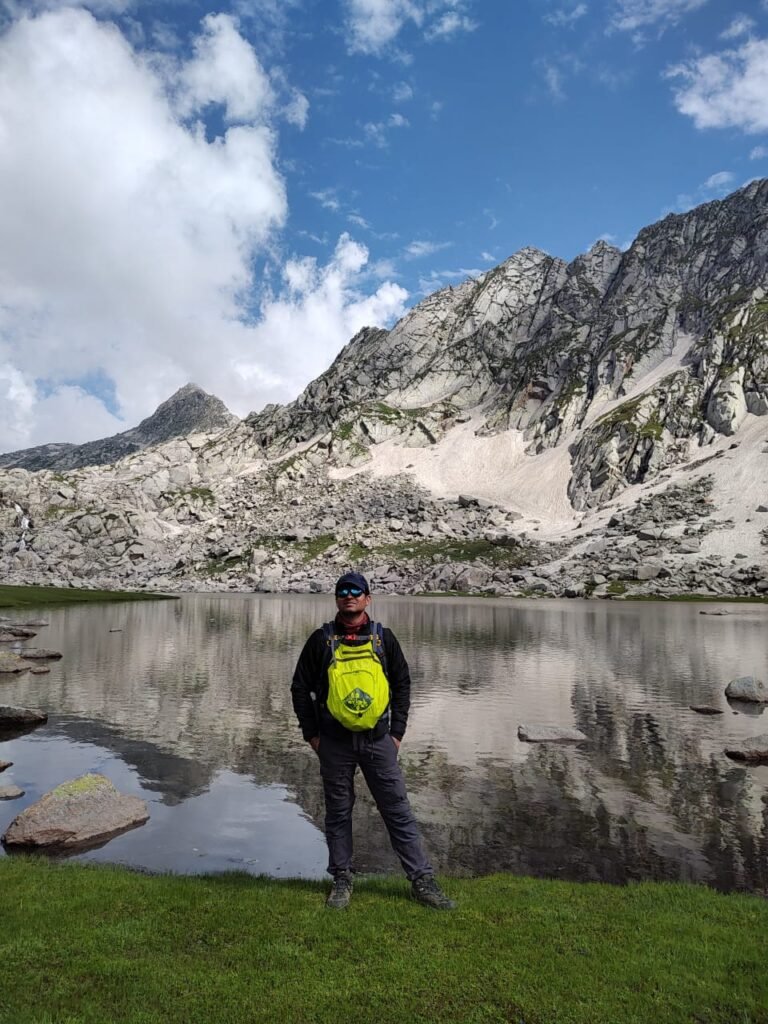Wondering how to reach Kareri Lake from Dharamshala or nearby towns? You’re not alone. Kareri Lake has become one of Himachal Pradesh’s most loved spots among nature lovers and trekkers. Hidden high in the Dhauladhar range, this beautiful alpine lake sits at around 2,950 meters above sea level and is known for its clear glacial water and peaceful surroundings. Let’s explore the best routes, travel options, and essential details to help you plan your visit.
Where is Kareri Lake Located?
Kareri Lake is situated in the Kangra district of Himachal Pradesh, about 26 kilometers from Dharamshala and 11 kilometers from Ghera village. The lake is formed by the melting snow of the Dhauladhar range and stays crystal clear throughout the year. The area around it is surrounded by pine forests, rocky trails, and stunning views of snow-covered peaks.
The base for the journey is Kareri Village, a quiet and scenic Himachali settlement that also serves as the starting point for the trek. Most visitors reach Kareri Village first and then continue their journey on foot to the lake.
How to Reach Kareri Lake from Dharamshala
If you’re starting from Dharamshala, here’s how to reach Kareri Lake step by step:
-
By Road to Kareri Village
From Dharamshala, take a local taxi or drive towards Ghera village (about 20 km). The road passes through beautiful countryside, pine forests, and small mountain settlements. From Ghera, continue another 5–6 km to Kareri Village, which is the last motorable point. -
Trekking from Kareri Village to the Lake
The actual Kareri Lake trek starts from the village. The trail is around 9 kilometers one way and takes about 4–5 hours to complete depending on your pace. The path runs alongside the Nyund River, crossing small wooden bridges and gentle slopes through pine and oak forests. -
Optional Route from McLeodganj
Some travelers prefer to begin their journey from McLeodganj, which is only 9 km from Dharamshala. You can take a taxi to Ghera or Kareri Village from there as well.
The trek is considered moderate, so even beginners can do it with basic fitness and a little preparation.
How to Reach Kareri Lake from Major Cities
Here’s how to reach Kareri Lake from other popular locations:
-
From Delhi – Take a Volvo or HRTC bus to Dharamshala (about 480 km, 10–11 hours). From there, follow the Dharamshala → Ghera → Kareri Village route.
-
From Chandigarh – The distance is around 250 km. You can drive or take a bus to Dharamshala and then proceed to Kareri.
-
From Pathankot – Pathankot railway station is the nearest major railhead, about 85 km from Dharamshala. From Pathankot, hire a taxi or take a local bus to reach Kareri Village.
-
From Amritsar – The distance is roughly 200 km. You can take a direct cab or bus to Dharamshala and continue towards Kareri Lake.
What to Expect on the Trek
Once you start walking from Kareri Village, the scenery changes with every turn. The trail follows small streams, open meadows, and dense forests filled with birds. As you climb higher, the air gets cooler, and the view opens up to the snow-covered Dhauladhar peaks.
At the top lies Kareri Lake, calm and crystal clear, reflecting the mountains like a mirror. A small Shiva Temple near the lake adds to the serene atmosphere. Many travelers camp overnight near the lake to enjoy the starry sky and mountain silence.
Stay and Food Options
While the area around the lake is remote, you can find small guesthouses and homestays in Kareri Village. During trekking season, locals also set up tents and food stalls along the trail. Meals are usually simple and homemade — rajma-chawal, parathas, and tea — offering a true Himachali taste.
If you prefer a guided experience, Hill Hikers Adventures of Himachal organizes safe treks with camping, meals, and expert local guides who know the route well.
Best Time to Visit Kareri Lake
The best time to plan your trip depends on what you want to experience:
-
Summer (May–July): Ideal weather, clear skies, and comfortable trekking conditions.
-
Post-Monsoon (September–November): Green trails and crystal-clear views.
-
Winter (December–March): The lake often freezes, and snow covers the trail — perfect for experienced trekkers.
Avoid the monsoon season (July–August) as heavy rainfall can make the trail slippery and risky.
Travel Tips Before You Go
-
Carry enough warm clothes and a light jacket.
-
Wear sturdy trekking shoes with good grip.
-
Bring a refillable water bottle — the streams have fresh drinkable water.
-
Don’t litter; respect the environment.
-
Hire local guides or join a trusted group like Hill Hikers for safety and authentic experience.
Final Thoughts
Reaching Kareri Lake is not just about the destination — it’s about the journey through the quiet and untouched side of Himachal. The road, the villages, the forest, and finally the lake — everything feels raw and refreshing. Now that you know how to reach Kareri Lake, all that’s left is to pack your bags and experience its calm beauty for yourself.
With Hill Hikers Adventures of Himachal, your journey becomes easier, safer, and filled with local insights that make the trip truly special.

